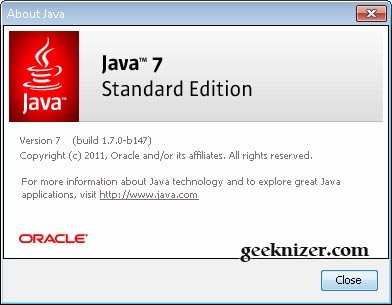 The long awaited and the most delayed version of Java is finally made available to public. The last Java update was in December 2006 and Java 7 was originally planned for 2009.
The long awaited and the most delayed version of Java is finally made available to public. The last Java update was in December 2006 and Java 7 was originally planned for 2009.
Oracle announced this morning that Java 7 has matured because of the hard work done by open review and extensive collaboration between Oracle engineers and members of the worldwide Java ecosystem.
“Java 7 is the release everybody has been waiting for quite a long time,” said Ben Evans of the London Java Community (LJC). Evans, who also is the LJC’s representative on the Java Standard Edition/Enterprise Edition (Java SE/EE) Executive Committee, added that Java 7 is “an enabler” that will give developers more options for building better Java applications.
- A new multicore-ready API that enables developers to more easily decompose problems into tasks that can then be executed in parallel across arbitrary numbers of processor cores. (JSR 166: Fork/Join Framework)
- Language changes to help increase developer productivity and simplify common programming tasks by reducing the amount of code needed, clarifying syntax and making code easier to read. (JSR 334: Project Coin)
- Expanded support for internationalization, including Unicode 6.0 support
- A comprehensive I/O interface for working with file systems that can access a wider array of file attributes and offer more information when errors occur. (JSR 203: NIO.2)
- Improved support for dynamic languages (including: Ruby, Python and JavaScript), resulting in substantial performance increases on the JVM. (JSR 292: InvokeDynamic)
- New networking and security features.
- System and Process CPU monitoring.
Java 7 New Features
Java 7 gives the Java platform a significant facelift not just in performance benchmarks but also on bunch of new features. Below are the features, enhancements in detail:
Full feature set is available here, you also checkout other features that were included to Java 7 a while ago.
Dynamic Language Performance Boost
Java 7 gets a new InvokeDynamic feature, enhancing the support for dynamic languages such as Ruby, Python and JavaScript to run on the Java Virtual Machine (JVM). InvokeDynamic is responsible for making these languages trun at a much faster speeds on top of JVM.
The JVM was obviously designed for Java, and all the invocation modes are organised around Java semantics, however, low-level support and a stronger under girding for other language features has now been officially added to JVM.
API for Parallel Programming / Multicore programming
Java Development Kit (JDK) 7 also features a new API for parallel programming or building applications for multicore systems. The new Fork/Join Framework enables developers to break down problems into subtasks that can be executed in parallel across a number of processors.
New I/O optimized for different Filesystems
Java 7 adds a new I/O for working with different file systems, new networking and security features, and backward compatibility with other versions of the platform.
We write latest and greatest in Tech Guides, Apple, iPhone, Tablets, Android, Open Source, Latest in Tech, subscribe to us@taranfx on Twitter OR on Facebook Fanpage:
loading...
loading...



what’s about GC problem with large heap, can JDK 7 now handle 30 – 100GB large heap efficiently, without significant pause time?
loading...
loading...
please make peace with google and make android a better OS .
it will surely pay off! 🙂
i like both android and java.
loading...
loading...
I think technology games rae more better than other games really we are getting knowledge, entertainment .Java technology having many features which are used for making many gmaes.
loading...
loading...